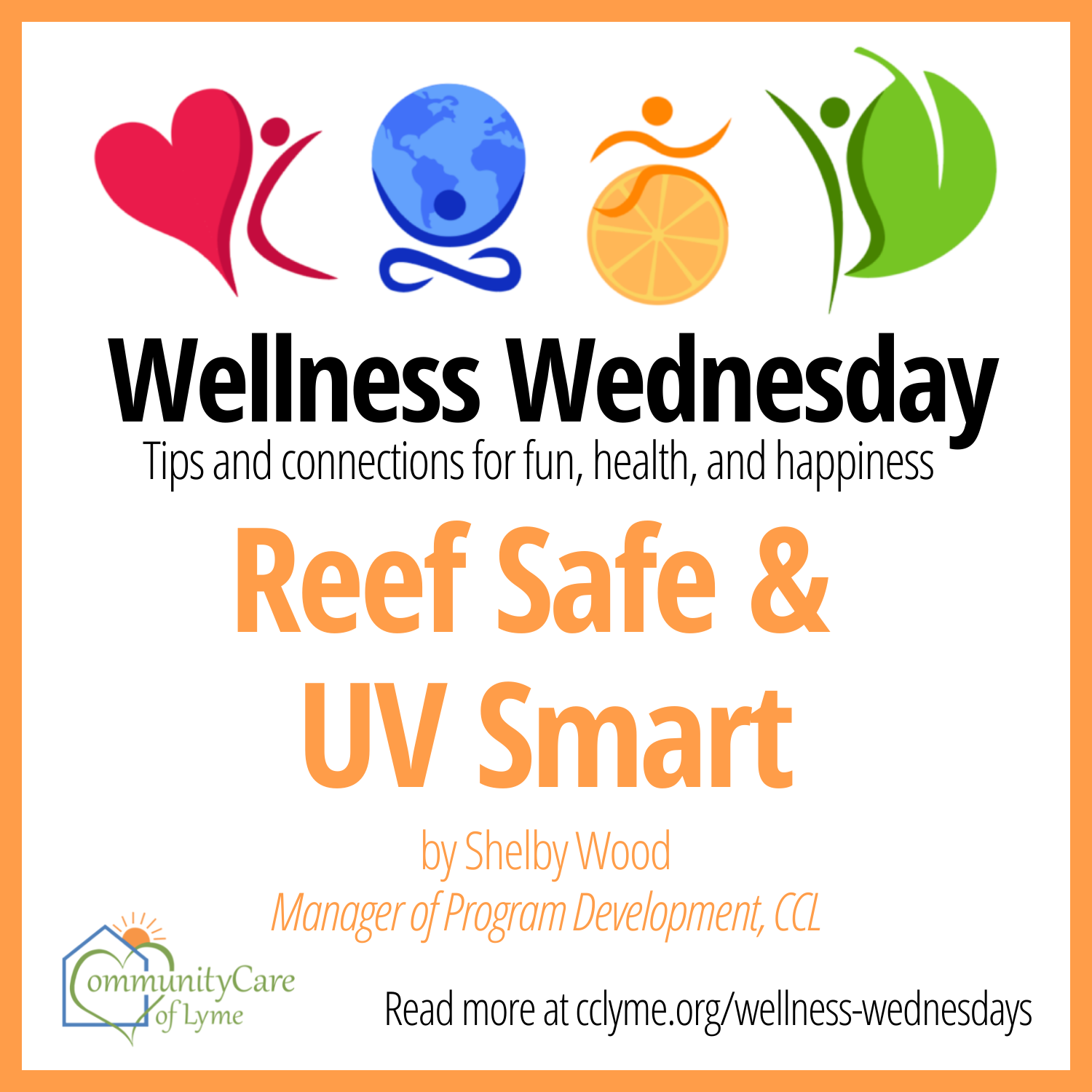Reef Safe & UV Smart
Submitted by Shelby Wood
If you haven’t seen headlines this week, there is growing concern over the stewardship and protective measures for the Great Barrier Reef. Just as the Upper Valley is beginning to see some summer weather, and our thoughts turn to time on the water, headlines like, “Unesco: Great Barrier Reef should be listed as ‘in danger'” (Khalil, BBC, 2021) and, “Australia rejects U.N. climate warning over Great Barrier Reef status” (Sulima, NBCnews, 2021) are a reminder that our day to day choices have a real environmental impact. While admittedly the thought of reef bleaching can feel distant from New Hampshire lakes and beaches, there are some simple choices we can make collectively to be stewards of our environment. According to the National Park Service (2020) there are two simple things we can do to be reef safe: cover up and look at the labels on our sunscreen.
Many times while we’re at the market and need sunscreen for a trip to the beach or lake we might pick-up what’s on sale, or what the dermatologist recommended for SPF without thoroughly looking through ingredients. Consumer Reports notes that even consumers trying to be reef safe, only buying sunscreen with that on the label, may be duped into buying a sunscreen that still contains ingredients harmful to marine animals. How can that be? Consumer Reports (Calderone, 2021) notes:
But oxybenzone and octinoxate—two of the most commonly used UV blockers worldwide—aren’t the only ingredients that may be damaging to marine life.
In fact, says Craig A. Downs, Ph.D., executive director of the nonprofit Haereticus Environmental Laboratory, though oxybenzone and octinoxate are the most widely studied, there are several other chemicals used in sunscreens and other personal care products that research suggests might be an environmental threat. And even sunscreens labeled “reef safe” aren’t guaranteed to be harmless when they leach into underwater ecosystems.
Choose a Reef Safe Sunscreen
When you do need to use sunscreen, or for areas that can’t be effectively covered with clothing, be aware that there are two types of sunscreen to choose from:
- Chemical sunscreens: Products that frequently contain the absorbable and coral harming ingredients mentioned above. It is best to avoid these.
- Physical sunscreens (also known as mineral or inorganic sunblocks): Products that use zinc oxide and titanium dioxide and are considered “safe” for use around coral reefs.* There is some new evidence suggesting that titanium dioxide may be safer for corals than zinc oxide. These are the best choice. (Sentman, Oceanic Society, 2018).
As we all navigate finding balance between saving our reefs, and saving our skin, I hope that some of the links listed below (works cited) will help inform and guide your quest. The video playing, “Reefs at Risk” gives an overview of both issues in a succinct way that I hope you find useful.

Above Image: “Reef-Friendly Sun Protection Campaign Graphics.” National Parks Service, U.S. Department of the Interior, 8 Dec. 2020, www.nps.gov/subjects/oceans/reeffriendlycampaigngraphics.htm.
Works Cited:
Anbouba, Margaux. “9 Reasons Why You Should Switch To A Reef-Safe Sunsceen Your SPF Might Be Hurting Marine Life and the Coral Reefs.” ELLE, 29 May 2020, www.elle.com/beauty/makeup-skin-care/g32685164/best-reef-safe-sunscreen/.
Sentman, Wayne. “Reef Safe Sunscreen: Our Guide to Ocean-Friendly Sun Protection.” Oceanic Society, 13 Apr. 2021, www.oceanicsociety.org/resources/blue-habits-tips/reef-safe-sunscreen-our-guide-to-ocean-friendly-sun-protection/.
Calderone, Julia. “The Truth About ‘Reef Safe’ Sunscreen.” Consumer Reports, 29 Apr. 2021, www.consumerreports.org/sunscreens/the-truth-about-reef-safe-sunscreen/.
Cloos, Kassondra. “The Best Reef-Safe Sunscreens Avoid Coral-Killing Chemical Sunscreens and Try One of These Safer Sun-Protection Methods.” Outside, 26 Oct. 2018, www.outsideonline.com/2357026/best-reef-safe-sunscreens.
Fagan, Malina and Lynn Pelletier, directors. Reefs At Risk – Hawaii Bans Sunscreens with Oxybenzone. YouTube, YouTube, 7 June 2018, www.youtube.com/watch?v=aGP9loQ0dqs.
Khalil, Shaimaa. “Unesco: Great Barrier Reef Should Be Listed as ‘in Danger’.” BBC News, BBC, 22 June 2021, www.bbc.com/news/world-australia-57562685.
“Reef Safe Sunscreen Guide.” Reef Safe Sunscreen Guide | Save the Reef, savethereef.org/about-reef-save-sunscreen.html.
“Reef-Friendly Sun Protection Campaign Graphics.” National Parks Service, U.S. Department of the Interior, 8 Dec. 2020, www.nps.gov/subjects/oceans/reeffriendlycampaigngraphics.htm.
“Reefs at Risk – What’s in Your Sunscreen?” THE COVERUP, 6 June 2021, thecoverupfilm.com/reefs-at-risk/.
Suliman, Adela. “Australia Rejects U.N. Climate Warning over Great Barrier Reef Status.” NBCNews.com, NBCUniversal News Group, 23 June 2021, www.nbcnews.com/news/world/australia-rejects-u-n-climate-warning-over-great-barrier-reef-n1271795.
Zhekova, Dobrina, and Rebecca Carhart. “How to Know If Your Sunscreen Is Killing Coral Reefs – and the Brands to Try Instead You’ll Want to Stock up on These Sunscreens This Summer.” Travel & Leisure, 25 Mar. 2021, www.travelandleisure.com/style/beauty/reef-safe-sunscreen.
If you have a wellness themed topic you would like to share or learn more about, and/or blog/vlog about as an expert in a health/wellness related field, please reach out to shelby@cclyme.org.
Shelby Wood
Manager of Program Development
CommunityCare of Lyme
Shelby@cclyme.org
802-468-7776








Leave A Comment